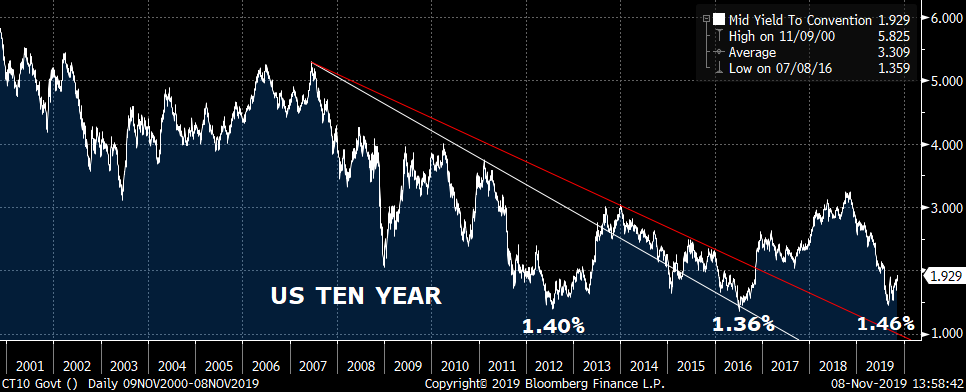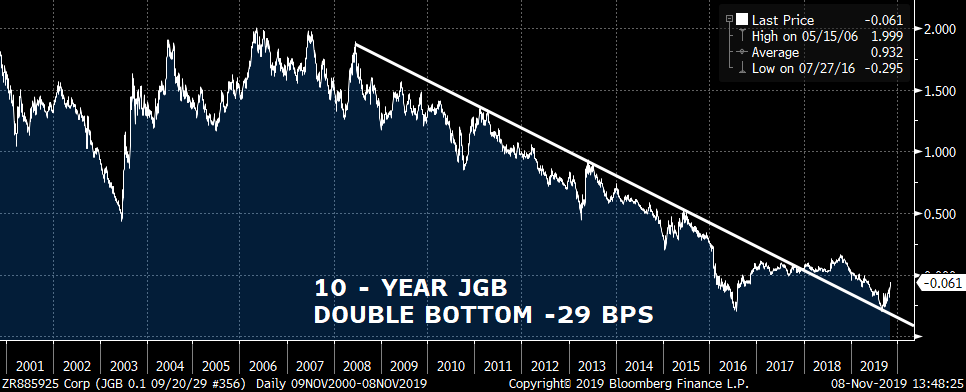Another case of repo indigestion coming?
November 10. 2019
https://www.bloomberg.com/news/audio/2019-11-08/why-the-repo-markets-went-crazy-podcast
I am starting with a link from Bloomberg which is a podcast with Zoltan Poszar about repo and liquidity issues. It’s about 50 minutes long, but well worth the listen.
On Friday, I saw this trade, EDZ9 9800/9812 strangle sold at 3.25. The 98.125c settled 2.5 and the 98.00p settled 1.0. As I saw it, I was thinking to myself, I would never do that trade. The upside risk is an unexpected ease in December while the downside is exposed to a funding crisis into year-end. Of course, a couple of weeks ago when I saw someone sell the 98.125 straddle at 16.0 (which now settles 9.0) I also wouldn’t have done it. I even mentioned at the time, that while the trade makes sense from a technical perspective, it would probably be a difficult short to hold. It hasn’t been. And now one could cover all straddle risk with a 9800/9825 strangle for 2.
NO ONE IS GOING TO HAVE THE BALANCE SHEET TO LEND INTO REPO AT YEAR END
That’s what Poszar says about this year end. In the podcast, he mentions a few things the Fed could do to alleviate the conditions that might lead to a funding crunch, but he doesn’t believe it’s likely that the Fed will implement them. We’ve already seen that banks had a meeting with the Fed, and that JPM’s Jamie Dimon openly asked for regulatory relief in terms of making reserves available, but the Fed does not want to go that route. The banks that have reserves to lend are holding them for Liquidity Coverage Ratio purposes. As Poszar says, post-crisis, with Basel III, no bank is going to lend what they MUST hold for regulatory reasons. And banks are not going to use intraday credit from the Fed due to reputation risk. (It sort of makes me wonder, if JPM could almost single-handedly contribute to big rise in repo, as occurred in mid-September, then why is SOFR considered a much better benchmark than libor?)
The summary of Poszar’s talk is that the taper caused a decline in excess reserves, and the additional factor of curve inversion took away foreign buyers at the margin, leaving dealers to absorb more supply, which needs to be funded in the overnight market. He notes that the size of the repo market has exploded, including sponsored repo. ”The country is funding itself overnight”. Of course, the curve shifting back to positive helps alleviate one aspect of this potential problem.
The Fed has worked to re-build reserves with its t-bill buying and balance sheet expansion. As many charts have shown, the Fed’s balance sheet went from $4.449T at the end of 2017, to the taper low of $3.762T at the beginning of September of this year, to $4.039T now with the ‘not-QE’ bill buying. Repo operations have eased funding pressures. Poszar’s point is that there still won’t be enough excess reserves available at year end.
This issue, if correct, is not currently being reflected in futures markets. Though there has been buying of EDZ9 9800 puts for 1.25 (settled 1.0 on Friday), there hasn’t been anything that could remotely be considered ‘reaching’. There are only 311k open interest in 9800 puts vs 495k in EDZ9 9812.5 calls. EDZ9 futures have 1.53 million open. The spread between EDZ9 and FFF0 has been extremely stable since the repo scare in September, holding between 37 and 39 bps. The high in Sept was 41.5. November 3-month dollars (EDX9) which expire in a week, settled at a rate just below libor (98.1025 or 1.8975%). The probability of another ease at the December FOMC has been significantly priced out. With the Nov FF contract at 98.4325, January’20 FF settled at 98.46 or 1.54% and was trading 98.455 late Friday, just 2.25 bps over Nov, signaling only about a 10% chance of an ease next month. The calendar is important. On December 11 the FOMC meeting occurs. On Monday, Dec 16, December Eurodollar contracts expire. According to the TBAC schedule, $78 billion of 3s, 10s and 30s will be auctioned in December, settling on Dec 16, representing $54 billion in new borrowing.
It wasn’t all that long ago that there was a craze for pot-bellied piglets as pets. The trend faded as time passed and those cute little piglets became voracious pigs. Similarly, the large borrowing appetite of the federal government is causing issues, and making it look more likely that the Fed will end up being the buyer of last resort.
In any event, yields are moving higher across the curve. This week US tens jumped 20 bps to 1.928%. Global yields are surging as well. The German bund has gone from -71 bps in August to -26 Friday. The French ten year from -43 bps to +3. Japan from -29 to -6 over the same time frame. Worldwide, there seems to be repudiation of negative yields as a policy tool. In the US, supply may be starting to weigh on bond prices. Bloomberg also ran a piece noting that term premium is increasing.
The charts below show a triple bottom in the ten year yield at 1.36 to 1.46. The top of the eight year range is slightly over 3%. The JGB has a double bottom at -29 bps. It might not be a synchronized global growth story, but it’s looking an awful lot like a globally synchronized rise in bond yields. I think it’s much more likely that the next 50 bps will be higher in yield rather than lower.


Early Monday morning Clarida gives a speech on Monetary Policy, Price Stability and Bond Yields. Powell gives Congressional testimony on the economic outlook on Tuesday and Wednesday. Turkey’s Erdogan is visiting the White House on Wednesday the 13th. CPI and PPI on Wednesday and Thursday, with Retail Sales and Industrial Production Friday.
OTHER MARKET/TRADE THOUGHTS
As predicted last weekend, some of the large long treasury put spreads were exited in the past week as yields rose. The smart money is covering shorts. With the market having accepted the idea of a pause in rate cuts, or maybe even the end of the cycle, Powell will likely stay with the new mantra that ‘the economy is in a good place.’
Eurodollar calendar spreads had a nice rally. Last week I suggested buying EDM21/EDZ21 for 1.5 with an objective of 9 to 10. Settled Friday at 4.5. On the week, the front March/March one-year calendar (EDH20/H21) rallied from -21.5 to -13.0.
Although yields have already had a nice move, I think there is potential for a further washout, especially if Powell talks up the economy and inflation prospects. Longer term I like buying put spreads on everything from greens to bonds, but am hoping a rally allows better entry.
Call me crazy but I think the Trump/Erdogan meeting could bring out other crazies. Security risk?
| 11/1/2019 | 11/8/2019 | chg | |
| UST 2Y | 156.2 | 166.2 | 10.0 |
| UST 5Y | 155.6 | 173.1 | 17.5 |
| UST 10Y | 172.8 | 192.8 | 20.0 |
| UST 30Y | 221.1 | 241.4 | 20.3 |
| GERM 2Y | -65.7 | -61.6 | 4.1 |
| GERM 10Y | -38.2 | -26.3 | 11.9 |
| JPN 30Y | 33.8 | 44.9 | 11.1 |
| EURO$ Z9/Z0 | -39.5 | -27.5 | 12.0 |
| EURO$ Z0/Z1 | -5.0 | 1.5 | 6.5 |
| EUR | 111.67 | 110.19 | -1.48 |
| CRUDE (1st cont) | 56.20 | 57.24 | 1.04 |
| SPX | 3066.91 | 3093.08 | 26.17 |
| VIX | 12.30 | 12.07 | -0.23 |
https://www.bloomberg.com/news/audio/2019-11-08/why-the-repo-markets-went-crazy-podcast
https://www.federalreserve.gov/fomc/minutes/19990824.htm
https://www.federalreserve.gov/fomc/minutes/19990824.htm

